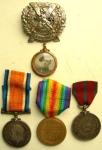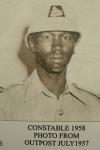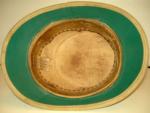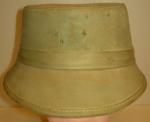-
Posts
13,225 -
Joined
-
Last visited
-
Days Won
22
Content Type
Profiles
Forums
Blogs
Gallery
Events
Store
Everything posted by Mervyn Mitton
-
Although they are to a particularly sought after unit - The London Scottish (14 - London Regiment) - they are still only a WW1 Pair. However, he was in the St. John's Ambulance Brigade and received the special named Coronation medal in 1911. Only (approx) 2600 were issued to the Brigade and this is the first I have seen for many years. St. John's is always highly collected. What also makes this an interesting group is that we have photos of Peters wearing his tam-o-shanter and the badge shown here , also, his wife and son. One thing that puzzles me is that he is named on the Coronation as Pte. F.A.Peters. I wasn't aware that the St.John's personnel were called Private - perhaps he was a territorial with the London Scottish at that time ?
-
The British South Africa Police wore a normal cap - shown some time ago under Police. However, the African Police wore a shako (sun helmet). I am showing it in this section since it was a standard style, also worn by the King's African Rifles - and other units within Sthn. Rhodesia, Nthn. Rhodesia and Nyasaland. (KAR wore a tarbosh in full dress). This example is in good condition for it's age , but is missing the lion and spear badge (anyone have a spare one ?). However there is a picture of one being worn. Inside the headband is his name and number - 22072 Mufari.
-

Irish Military Uniform?
Mervyn Mitton replied to HugoB268's topic in Great Britain: Militaria: Badges, Uniforms & Equipment
Hi - Kevin - yes, I'm going by the white and if he didn't serve elsewhere then the KSA would follow. Can't make it out properly. As for troops awarding extra medals, bars etc. - you would be amazed how common it is - they didn't like to go to re-unions or local events and have fewer than the next man... The worst I ever had was a group starting with 1879 Zulu, through 1882 Egypt, then Boer War and WW1. I think it was 6 or 7 medals - every medal to a different unit and only the WW1 War Medal was actually his. He applied for a pension for all of them - this was granted - but, in 1921 they obviously checked the records and stopped his pension. He cont. to appeal against this until the late 1920's - all the letters were with the medals. -

Irish Military Uniform?
Mervyn Mitton replied to HugoB268's topic in Great Britain: Militaria: Badges, Uniforms & Equipment
I would have thought the green and white of the KSA - he may have awarded it to himself - many did ? I think he has the 'cheekiest' Irish smile... -
It is of course a 'Sweetheart Brooch'. Started mainly with the Boer War and they were common in both World Wars. Servicemen - of all ranks - gave their wives and girlfriends a brooch showing the Regt. or,unit they were serving in - the ladies then wore it to show the link with their husband. Even o/r's could give silver and gold brooches - but usually, when diamonds are present it will be from a senior officer. I have seen many of this quality - this one is of silver, gold and with quite a number of diamonds. I would think at auction it could easily go for £600 - £700 or, even more. A lot would depend on the quality of the diamonds - which of course you can't see in a picture. (My ident. iis based on a small size for a sweetheart brooch. There are in fact 60 small diamonds and chips.)
-
Thankyou Norman - you can never have too many ref. books.
-

QUEEN and KING SOUTH AFRICA MEDALS
Mervyn Mitton replied to a topic in Great Britain: Orders, Gallantry, Campaign Medals
Darrell - another nice clean medal , with good patination. Your contact has found you some good medals - and you have increased his pension fund ... When the War broke out all mines had to be closed and about 3000 men were drafted into service - this unit being one. They also formed and ran the Military railway in the Transvaal, with three armoured trains. -

A RARE BOER WAR MEDAL
Mervyn Mitton replied to Mervyn Mitton's topic in Great Britain: Orders, Gallantry, Campaign Medals
Rick - you make it sound like 'witchcraft' - but you do exactly the same thing on a daily basis - just in a different field. When you deal with things on a daily basis - 'you just know' - certainly not infallible, but a good guide. I have bought 5 groups in the past week and you have to make a decision on quality, genuiness and price - if you make a mistake it's yours, not a museum who can back pedal if necessary. I think most of our members do exactly the same - I asked a question on members info. this afternoon and in 3 minutes I had received an ident.. We have had the shop seventeen years and only once have been asked for a refund - and that turned out not to have a genuine reason. I made one serious mistake a few years ago - and it is going to be a question , because I think our medal members will enjoy the 'tracking'. It was for a 1st.WW DFM and there are a number of queries - even though it was from the daughter who was 87 ! Will dig it out and see if you can help. -
This early truncheon dates back to 1841 and was carried by the Quartemaster for the British Government Expedition of that year. Known as the Niger Expedition it was commanded by Captain William Allen R.N. and was carried on board H.M.S. Albert. For the trip up the River there were three iron paddle steamers and a combined strength of 150 Europeans and 150 Africans. This was - in many ways a political statement - to show the World that we intended to take a leading role in the exploration of Africa - still very much the 'Dark' continent in those days. There were a number of stated reasons for the mission - the first was the inland suppression of slavery. This was very prevalent among the tribes and the captured victims ended up in Southern US States and Sth. America. We also wanted to make contact with the chiefs of the inland tribes to establish our influence and to make a statement to other European countries. Finally, we wanted to explore the Niger River to find the headwaters. The expedition was quite succesful - but in 1842 was struck down by 'fever' (this was probably malaria - although there were a number of other serious ones) and they were withdrawn. Britain had a large Empire and truncheons and tipstaffs are known from Australia, India, Ceylon,South Africa, Canada and Britain - and they can be named to many different offices - however, I have never heard of one named to an expedition. The arms are the type introduced for Queen Victoria and help date this to 1841. The condition is exceptional for it's age and for the rough areas it has visited - price wise - well in excess of $2500...
-

A RARE BOER WAR MEDAL
Mervyn Mitton replied to Mervyn Mitton's topic in Great Britain: Orders, Gallantry, Campaign Medals
Alan - probably should read Royal Lancs. Regt.. I would feel my price is about right - if anything, a little less. -

A RARE BOER WAR MEDAL
Mervyn Mitton replied to Mervyn Mitton's topic in Great Britain: Orders, Gallantry, Campaign Medals
Hi- Alan. I would think around £150 -$240. However, this could change either way - dependent on naming. Please give the details from around the rim of the medal and we can check on him. Mervyn -
Mossy - as you say seems old for the rank. However, you know it was a small unit, so probably didn't rate a higher rank - and in the old colonies it was a prestigious thing to be a local officer. Hope you can 'pin' him down in Adelaide. The info. you have turned up is certainly worth the effort you have put into the enquiries. Please let us know progress.

















